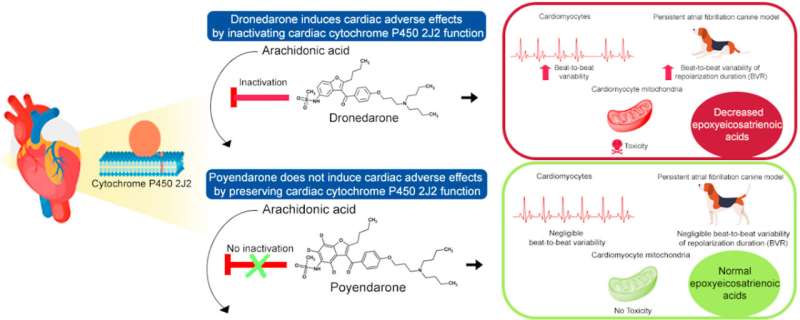Site-directed deuteration of dronedarone mitigates cardiac adverse effects in canine arrhythmic hearts

In a new article published in Acta Pharmaceutica Sinica B, authors Aneesh V. Karkhanis, Gopalakrishnan Venkatesan, Ryuichi Kambayashi, Atsushi Sugiyama, Eric Chun Yong Chan and colleagues from the National University of Singapore; Toho University, Tokyo, Japan, and the Agency for Science, Technology and Research, Singapore, discuss how site-directed deuteration of dronedarone preserves cytochrome P4502J2 activity and mitigates its cardiac adverse effects in canine arrhythmic hearts.
Cytochrome P4502J2 (CYP2J2) metabolizes arachidonic acid (AA) to cardioprotective epoxyeicosatrienoic acids (EETs). Dronedarone, an antiarrhythmic drug prescribed for treatment of atrial fibrillation (AF) induces cardiac adverse effects (AEs) with poorly understood mechanisms. Dronedarone inactivates CYP2J2 potently and irreversibly, disrupting the AA-EET pathway leading to cardiac mitochondrial toxicity rescuable via EET enrichment.
In this study, the authors investigate if mitigation of CYP2J2 inhibition prevents dronedarone-induced cardiac AEs. Deuterated analog of dronedarone (termed poyendarone) was synthesized, and the authors demonstrate that it neither inactivates CYP2J2, disrupts AA-EETs metabolism nor causes cardiac mitochondrial toxicity in vitro. Patch-clamp experiments demonstrate that pharmacoelectrophysiology of dronedarone is unaffected by deuteration. Next, the authors show that dronedarone treatment or CYP2J2 knockdown in spontaneously beating cardiomyocytes indicative of depleted CYP2J2 activity exacerbates beat-to-beat (BTB) variability reflective of proarrhythmic phenotype. In contrast, poyendarone treatment yields significantly lower BTB variability compared to dronedarone in cardiomyocytes indicative of preserved CYP2J2 activity. Importantly, poyendarone and dronedarone display similar antiarrhythmic properties in the canine model of persistent AF, while poyendarone substantially reduces beat-to-beat variability of repolarization duration suggestive of diminished proarrhythmic risk.
The findings prove that deuteration of dronedarone prevents CYP2J2 inactivation and mitigates dronedarone-induced cardiac AEs.
More information: Aneesh V. Karkhanis et al, Site-directed deuteration of dronedarone preserves cytochrome P4502J2 activity and mitigates its cardiac adverse effects in canine arrhythmic hearts, Acta Pharmaceutica Sinica B (2022). DOI: 10.1016/j.apsb.2022.03.008
















